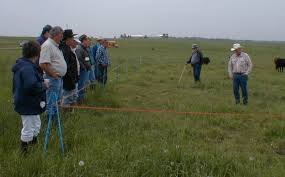Agro-Culture Field Day: Research-Based Proof Of Performance
August 14-2013
In the world of plant fertility, the proof is always in the pudding, as witnessed on a recent tour of Agro-Culture Liquid Fertilizer’s 631-acre St. Johns, MI-based research farm.
Initially launched in 1994 as a 30-acre research plot, St. Johns, MI-based manufacturer Agro-Culture Liquid Fertilizer’s (ACLF) North Central Research Station (NCRS) has, much like the company itself, experienced explosive growth over the past 15 plus years. Today, the facility features a healthy 631 tillable acres, the vast majority of which are irrigated. Besides housing a portion of the company’s administrative offices, the property consists of 11 research plots of differing soil types and soil nutrient levels that collectively make up the NCRS.
Here, traditional Midwestern row crops such as corn, soybeans and winter wheat are grown alongside an array of specialty crops such as sugarbeets, navy beans, pumpkins and strawberries, all in the name of demonstrating the benefits of Agro-Culture’s full line of liquid fertilizer and micronutrientmanagement products.
Plenty Of Research
“Agro-Culture Liquid does a lot of research and training here in fertilizer efficiency, and we’re able to take that information and apply that to our customers’ farms and fields to give them maximum response for the dollars they spend,” says Cory Schurman, Agro-Culture senior agronomy manager during one of the company’s 2012 Field Day tours. “All of this research and hands-on training is the key to applying what we learn to growers’ fields and giving them answers.”
Getting growers to switch fertility programs is a significant challenge for even the most polished sales professional. According to Schurman, one of the first questions a prospective grower-customer will ask the company is simply “Why? — Why should I switch what I’ve been doing for years and go with you guys?”
For ACLF, the first step in addressing those concerns is showing growers what sets the company apart from competing products and manufacturers. One such factor, according to the company, is the lower salt-index of ACLF products, which allows for decreased volatility and nitrogen (N) leeching.
“Salt Indexes are a measurement where you measure the effects of that material on plant tissue, both above and below ground,” says Schurman. “When we have lower salt indexes, we can get those nutrients into that plant tissue with no negative side effects, no negative burns, so you can get a lot better effectiveness, or yield reaction, from those nutrients that are applied. So this is a key component in the quality and usability and the uptake of nutrients.”
Varied Product Offerings
Another defining characteristic of ACLF is the vast array of fertility products they can offer. From Pro-Germinator, a dual-form phosphate fertilizer with multi-form N, to eNhance, a nitrogen supplement formulated to produce greater N availability and reduce input costs, the company pledges “effective, environmentally-responsible crop nutrition” through its diverse product.
Normally the term “low rate” can carry with it a negative connotation. Not so in the world of crop fertility, where growers and crop consultants are constantly chasing the Holy Grail of more yield with less inputs.
Agro-Culture’s grower-customers are no different, which is precisely why the company is so bent on initiating long-term research trials to find the most efficient fertility programs for their growers across a wide variety of crops.
One such trial is Agro-Culture’s “It’s Nutrients, Not Numbers!” study, otherwise known as the “Corn Fertility For A Permanent Plot Rotation Fertilizer Program Comparison.” A long-term research program in just its second year, the aim of the study is “to determine the long-term effects of the ‘low rate’ approach of Agro-Culture Liquid Fertilizers high usability nutrition in comparison to higher rates with conventional fertilizers.” The study initially established a yield goal of 180 bushels per acre (bu/A) based on soil samples recommending a minimum N rate of 175 pounds per area.
The study’s findings back Agro-Culture’s claims, with the N-only (47 gallons of 28% N + eNhance) regimen producing the lowest yield, yet still surpassing yield goals at 195.5 bu/A. A conventional dry fertilizer program (100 pounds 0-0-60 + 65 pounds 18-46-0 + 8 pounds zinc + 365 pounds urea) was next in line at 202.4 bu/A, while the most dramatic yield increases came from deploying the full ACLF portfolio of products (3 gallons Pro-Germ. + 5 gallons Sure-K + 2 quarts Micro 500 [in-furrow]+ 47 gallons 28% + eNhance [sidedress]), which resulted in a yield of 214 bu/A.
So despite applying 40% less primary nutrients per acre, the Agro-Culture Liquid Fertilizers treatment had the highest yield response, significantly higher than that of the N only and the Conventional Dry treatment.
Being a research-based operation with nine full-time researchers on staff, after proving the effectiveness of reduced application rates of ACLF products in corn, the company wondered what would happen to yield if they also lowered the rates of the conventional fertilizers to match that of the recommended rates of ACLF products? Were they simply lucky in finding a significant yield increase in the first study or did the ACLF products truly increase yields? As with the previous study’s differing rates of application, the numbers show that the ACLF program significantly out-yielded the conventional program (202.9 bu/A conventional vs. 214 bu/A liquid), indicating higher efficiency via the ACLF nutrition.
“Our research shows that using nutrients in a compilation — where we can get the best uptake and the best balance to give us the biggest response — is a key part of pushing yields higher and giving growers the results they’re looking for,” says Schurman.
